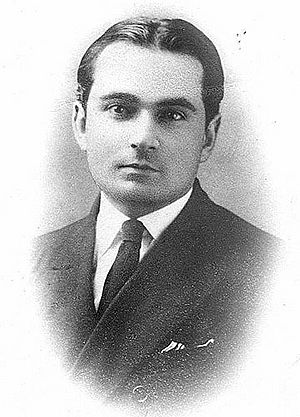Jorge Basadre facts for kids
Quick facts for kids
Jorge Basadre
|
|
|---|---|

Basadre in 1924
|
|
| Born |
Jorge Alfredo Basadre Grohmann
12 February 1903 Tacna, Chile
|
| Died | 29 June 1980 (aged 77) Lima, Peru
|
| Nationality | Peruvian |
| Alma mater | National University of San Marcos |
| Occupation |
|
| Employer |
|
|
Notable work
|
Historia de la República del Perú |
| Spouse(s) | Isabel Ayulo Lacroix |
| Children | 1 |
| Parent(s) |
|
| Awards |
|
| Minister of Education of Peru | |
| In office 28 July 1945 – 6 October 1945 |
|
| President | José Luis Bustamante y Rivero |
| Prime Minister | Rafael Belaúnde Diez Canseco |
| Preceded by | Enrique Laroza |
| Succeeded by | Luis E. Valcárcel |
| In office 28 July 1956 – 1958 |
|
| President | Manuel Prado Ugarteche |
| Prime Minister | Manuel Cisneros Sánchez |
| Preceded by | Juan Mendoza Rodríguez |
| Succeeded by | Ulises Montoya Manfredi |
Jorge Alfredo Basadre Grohmann (12 February 1903 – 29 June 1980) was a Peruvian historian known for his extensive publications about the independent history of his country. He served during two different administrations as Minister of Education and was also director of the Peruvian National Library.
Early life
Jorge Basadre was born to Carlos Basadre Forero and Olga Eloísa Grohmann Butler in Tacna, which was then under Chilean administration. Basadre said that his great grandfather was José Toribio Ara y Cáceres, a cacique who participated in the Peruvian War of Independence. Basadre began his training at the Liceo Santa Rosa, a Peruvian school that operated clandestinely in Tacna but changed to the German School of Lima when his family moved to this city in 1912. He undertook his final year of secondary education at Our Lady of Guadalupe National School in 1918.
In 1919, Basadre entered the National University of San Marcos where he graduated as a Ph.D. in humanities in 1928 and in law in 1935. While studying, he intervened in the University Conversation of 1919, along with other young students of the so-called Generation of the Reformation, and he also worked at the Peruvian National Library from 1919 up to 1930. He was a professor at the Universidad Nacional Mayor de San Marcos in 1928, teaching a course in the History of Peru. In 1929 he assumed the titular chair of History of the Republic of Peru, and in 1935 that of History of Peruvian Law, which he held until 1954 (although with intervals due to absences outside the country), when he departed from professional teaching to devote himself entirely to research. He undertook postgraduate studies in the United States and Germany between 1931 and 1935, receiving a scholarship from the Carnegie Institution to study in the United States and taking his courses at the Humboldt University of Berlin. During that time, he traveled to Spain to conduct research in archives at the University of Seville.
Public life
Between 1925 and 1926 he was part of the Peruvian delegation that was sent to the south to coordinate the holding of the Tacna and Arica plebiscite. He was carrying out this task when he was wounded by a stone in the head, thrown by a Chilean nationalist. The plebiscite was never held due to lack of guarantees. Two years later, Tacna was definitively reincorporated to Peru, while Arica remained in the power of Chile (1929).
Back in Peru, Basadre became director of the Central Library at San Marcos University, which he reorganized between 1936 and 1942. After a fire in the Peruvian National Library on 9 May 1943, Basadre was named its director and put in charge of its reconstruction. His work here included rebuilding the book collection and organizing the publishing of the Library magazine, Fénix, as well as Anuario Bibliográfico Peruano. After facing long hours of work and overcoming great difficulties, in September 1948 he was able to finally reopen the renovated National Library.
For a short period in 1945 he was named Minister of Education by president José Luis Bustamante y Rivero. He was elected to the presidency of the Instituto Histórico del Perú (Historic Institute of Peru) for the period 1956-1962. Peruvian president Manuel Prado Ugarteche named him Minister of Education a second time in 1956, a post he held until his resignation in 1958.
He was professor of History of Peru at Colegio Guadalupe (1929-1931) and at the National Pedagogical Institute (1930-1931); exerted the doctoral chair of History of Peru at the Pontifical Catholic University of Peru (1935); and he was professor of critical history of Peru at the Chorrillos Military School (1941-1945).
He was secretary general of the XXVII International Congress of Americanists, based in Lima (1939).
He was president of the Historical Institute of Peru (today National Academy of History), from 1956 to 1962; member of the Peruvian Academy of Language (since 1941) and member of the Geographical Society of Lima.
He was awarded the Order of the Sun of Peru in the degree of Grand Cross in 1979.
Private life
He married Isabel Ayulo and had a son named Jorge Basadre Ayulo.
Death and legacy
Jorge Basadre died on 29 June 1980, in the city of Lima at the age of 77.
A Peruvian University is named after him, Jorge Basadre Grohmann National University in Tacna. Since 1991, when the nuevo sol became the official currency of Peru, his portrait has appeared on the S/. 100 banknote. In 2008 a province that bears his name in his honor was created in Tacna.
See also
 In Spanish: Jorge Basadre para niños
In Spanish: Jorge Basadre para niños

